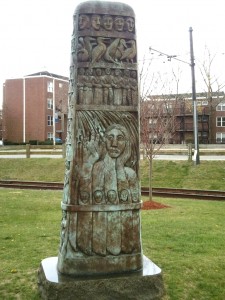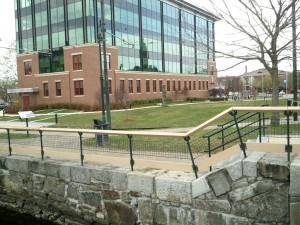‘Stele for the Merrimack’ by Peter Gorfain (commentary)
This is the first in a series of short commentaries about the Lowell Public Art Collection by students from an Art History course taught this spring by Prof. John Christ of the UMass Lowell Cultural Studies Dept.
Stele for the Merrimack
By Carolyn Campbell
One of the last installed pieces of the Lowell Public Art Collection, Stele for the Merrimack, is, arguably, the clearest expression of the city’s eternal dependence on the Merrimack River for its livelihood. It is located at the corner of Father Morrisette Boulevard and Suffolk Street on a shared property containing a little parkland belonging to Lowell Historical National Park and a Jeanne d’Arc Credit Union office building. Sculpted by Peter Gourfain in 1996, Stele for the Merrimack is a bronze column with symbols and figures carved in relief and stands approximately seven feet tall on a square granite base. A narrative runs along each of its four sides as images of female and male mill-workers are interwoven with items from nature (i.e. “Lowell in its wild state”).
At the time of the stele’s original installation in 1997, the crumbling ruins of Tremont Mill stood where the bank building is today. After city planners opted to develop the site in the early 2000s, the mill was demolished with the condition that the park space and stele remain. The sculpture sits on a small mound within a landscaped open space just feet away from the building.
Delineated by the building’s walkway, the sculpture’s park space is obvious if one enters from the north side. However, if one approaches it from downtown (home to the tourist-drawing historic sites and the majority of the Lowell Public Art Collection), it looks like the sculpture is on private property. This is concerning because there is a limited volume of pedestrians who would pass by the sculpture and take interest in it. This lack of visibility and relation to its location raises the call to move the stele to where it was originally designed—the canal-side parkland adjacent to the Tsongas Center and Riverwalk. The stele would convey its strongest meaning if it was relocated to within sight of the river for which it was named. Though relocation would require notable effort and pose challenges, the potential to reinstill this work and Lowell’s waterways with deeper significance suggests that this endeavor would be worthwhile.
Photo by Carolyn Campbell

